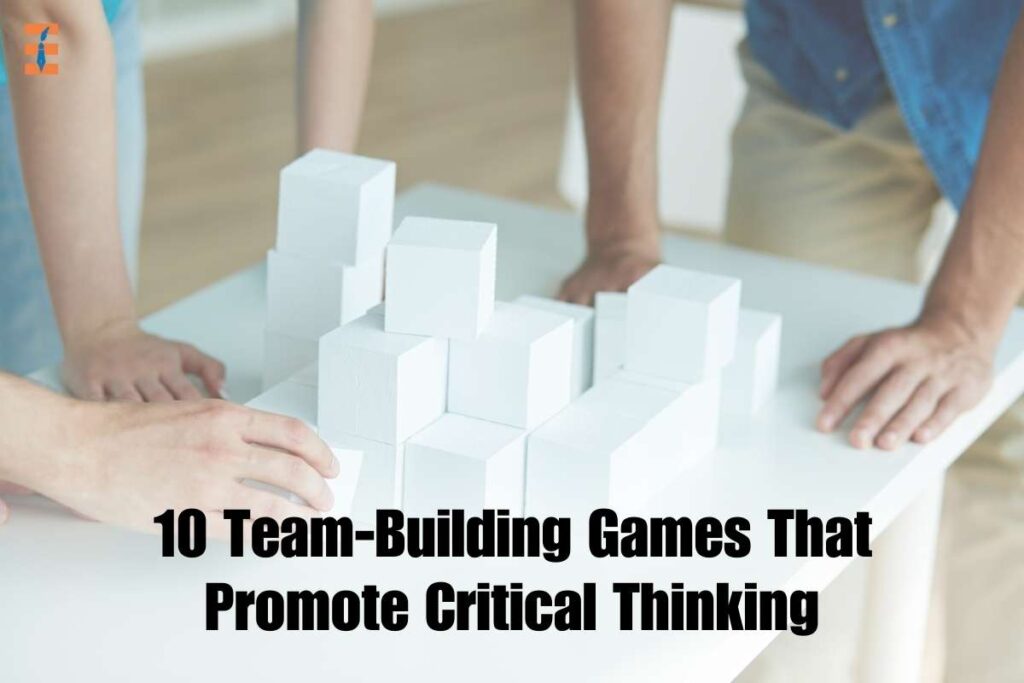Students may improve their capabilities in critical thinking and other skills that will help them be successful in the contemporary job by participating in Team-building games for critical thinking. Students who value collaboration (and who will go on to become employers!) have higher levels of motivation and creativity.
It is common knowledge that kids like collaborating in groups very lot. Why don’t we make it into a game instead? Games are often a better option than brain training activities for helping children develop lateral thinking. However, brain training activities may be employed. Implementing these strategies in your classes can help students become more critical thinkers and more successful collaborators.
Here are 10 Team-Building Games That Promote Critical Thinking;
1. Minefield
Minefield Team-building games for critical thinking is a time-honored exercise that has been shown to foster better communication and a sense of trust among participants of all ages. It requires the construction of an obstacle course as well as the grouping of the students into different teams. Students take turns navigating the “minefield” while wearing blindfolds and relying only on the support of their classmates to find their way. You might also encourage kids to use certain terms or hints in order to make it more challenging for them or to utilize information that is related to the topic in order to make it more interesting to them.
2. If You Build it
This exercise in establishing teams may easily be adapted to fit your needs. To get started, separate the children into teams and give each group an equal quantity of a certain substance. Some examples of this material are pipe cleaners, bricks, dried spaghetti, and marshmallows.

After that, you should assign them a project to work on. The challenge may take on a variety of forms, such as “which team can build the biggest castle that is also structurally sound?” Which side has the capacity to build the greatest number of castles in the least period of time? You may recycle this exercise throughout the year by modifying the challenge or the resources to correspond to other subject areas in the curriculum.
3. It’s a Mystery
Since many children, especially younger ones, like a good mystery, why not challenge them to solve it in a way that encourages them to collaborate with one another? It would be helpful to offer each child a numbered clue. The youngsters need to cooperate in order to find the answers to the clues in order to allow themselves enough time to solve the mystery, such as the case of the missing mascot. It’s possible that in order to solve the “case,” they’ll need to go about the room and look in other areas for additional clues.
4. Zoom
Zoom team-building games for critical thinking is an old standby when it comes to games for constructing teams, and the many advantages that come with playing the game make it even more interesting. The children are seated in a circle, and one child gives each child an image of an item from Zoom.
The game begins with one child relating a story based on the image that they are holding, and the next student continues the story from where the previous student left off. The game helps youngsters improve their creativity, critical thinking, and communication abilities by compelling them to create the tales on the spot and challenging them to think critically about what they’ve written.
5. Save the Egg
During this team-building games for critical thinking, each team of three or four persons will have the opportunity to drop their egg from a certain height. They need to devise strategies that will prevent the egg from cracking while it is in the air. They are free to use whatever items or apparatus of their choosing to effect a soft landing for the egg or to guarantee that it settles in an unharmed state.
Because this one has the potential to get ugly, it is essential to choose a site that is risk-free and where no one will be worried about hurting valuable school property.
6. marshmallows-game

After that, you should assign them a project to work on. The challenge may take on a variety of forms, such as “which team can build the biggest castle that is also structurally sound?” Which side has the capacity to build the greatest number of castles in the least period of time? You may recycle this exercise throughout the year by modifying the challenge or the resources to correspond to other subject areas in the curriculum.
7. Go for Gold
The teams compete to achieve the same objective in this Team-building games for critical thinking, which is similar to the game “If you create it,” but rather than having the same resources, the teams have access to a huge quantity. For instance, the objective may be to construct, consisting of pipes, rubber tubing, and cardboard, a machine that, with the only assistance of gravity, can move a marble from point A to point B in a certain number of stages.
Although learning through textbooks is essential, teachers also have a responsibility to ensure that pupils can interact effectively with one another. Exercises that focus on fostering a sense of teamwork are an effective way to do this, and there is no sign that this fad will ever die out.
8. Keep it Real
Because it is founded on a straightforward concept that encourages conversation and problem-solving, this open-ended model functions as an efficient examination tool for students. Give the students the mission to identify and address a genuine issue that exists in their own schools or communities. For the purpose of assisting youngsters in defining their own boundaries, some restrictions, such as time limits, material limits, and physical limitations, might be put on them.
9. Shrinking Vessel
Critical thinking may be tough to understand after undergoing brain training, but after participating in exciting Team-building games for critical thinking like the shrinking vessel, it quickly becomes second nature. The participants will first be split up into smaller groups to begin the exercise. Every group is going to have to coordinate their efforts so that they can fit into a smaller and smaller area until there is no more room. Cones or a rope might be used to define the perimeter of the area. Playing this game will teach you how to collaborate with others to find solutions to challenges.

10. The Worst-Case Scenario
Students are split up into two or more groups, and each of those groups is given a tough scenario to solve. Some examples of these scenarios include being abandoned on a barren island or becoming lost at sea. They are then given the instruction to collaborate with one another within their teams in order to find a solution to the challenge and ultimately emerge triumphant. The children have to come up with a strategy in order to guarantee that everyone will live through the worst-case scenario.
In this particular situation, the students may be quizzed about the things that they will need in order to do the task, in addition to any other passages that they may come across. The fact that youngsters are required to cooperate with one another helps in the development of their ability to solve problems and teaches them the importance of working together as a team through Team-building games for critical thinking.
Bottom line
To achieve the highest productivity at work, Team-building games for critical thinking are conducted in distinct corporate games. However, these games can boost efficiency in the study if undertaken in a classroom atmosphere. They help students to break the monotony in the learning environment. We hope our blog helped you to get new ideas regarding Team-building games for critical thinking. You can implement them in your next session within the classroom.










